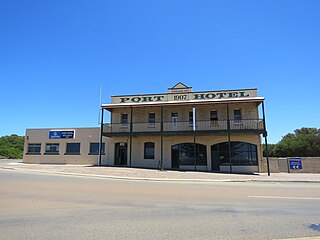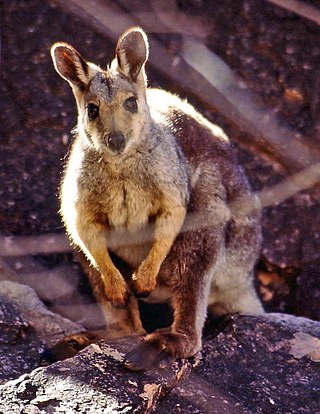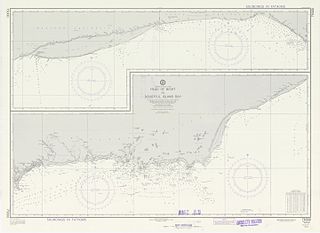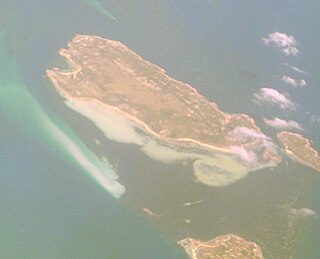
John 'Black Jack' Anderson (d 1837) was an African-American sealer and pirate active in the Recherche Archipelago off the south coast of Western Australia. [1] [2] [3] [4] [5]

John 'Black Jack' Anderson (d 1837) was an African-American sealer and pirate active in the Recherche Archipelago off the south coast of Western Australia. [1] [2] [3] [4] [5]
Anderson arrived in Western Australia's Recherche Archipelago on the cutter Mountaineer in 1835 from Kangaroo Island in what was to become South Australia, setting up base on Middle Island (near modern day Esperance). [1] [6]
Anderson and his fellows established an encampment on Middle Island as it was one of the few islands with a source of fresh water. The archipelago was heavily populated by Australian sea lions and New Zealand fur seals, and Anderson's band soon enriched themselves by trading furs to settlements along the coast; they are noted as visiting Kangaroo Island and the Althorpe Islands in South Australia. They supplemented their sealing income by robbing vessels travelling between Western Australia and the east coast colonies. They are also said to have murdered Indigenous Kaurna men and abducted women to take as sex slaves. The Recherche Archipelago was treacherous and uncharted, making it an ideal hideout for the pirates. [7] [8]
In September 1834 Anderson and another black man, John Bathurst, arrived at Kangaroo Island from Long Island and clashed with whalers and Aboriginals. [6] [9]
According to an 1842 report complaining about the lawlessness of sealers:
One of the most daring of these people was a man of color of the name of Anderson, and lawless as these men were, they looked up to him with a sort of dread. Anderson usually carried a brace of pistols about him, knowing that he held his life by a very precarious tenure. By persevering exertions he had amassed a considerable sum of money, and usually kept one or two black women to attend on him and minister to his wants, when not engaged in sealing. [8]
Anderson was eventually murdered by his fellow pirates, and is thought to be buried somewhere on Middle Island. [1] [2] According to a contemporary report:
They got quite disgusted with Anderson's harshness, and determined to remove him, but were puzzled how to accomplish it, as he was a stout, powerful man, and being armed was always on his guard. At last, one day when he was asleep in the tent, one of them entered and, taking deliberate aim, blew his brains out. The corpse was thrown into a hole, and covered over with earth, they then shared the booty, and killed the native woman [he was with] in case she should afterwards tell the tale. [8]
The reputation of the island as a lawless place continued for some time; in 1848 The Inquirer called it "the resort of a set of lawless desperadoes, composed of runaway convicts, sealers, etc." [10] [5]

Cape Le Grand National Park is a national park in Western Australia, 631 km (392 mi) south-east of Perth and 56 km (35 mi) east of Esperance. The park covers an area of 31,801 hectares The area is an ancient landscape which has been above sea level for well over 200 million years and remained unglaciated. As a result, the area is home to many primitive relict species. Established in 1966, the park is managed by the Department of Parks and Wildlife. The name Le Grand is from one of the officers on L'Espérance, one of the ships in the 1792 expedition of Bruni d'Entrecasteaux.

The Noongar are Aboriginal Australian people who live in the south-west corner of Western Australia, from Geraldton on the west coast to Esperance on the south coast. There are 14 different groups in the Noongar cultural bloc: Amangu, Ballardong, Yued, Kaneang, Koreng, Mineng, Njakinjaki, Njunga, Pibelmen, Pindjarup, Wadandi, Whadjuk, Wiilman and Wudjari. The Noongar people refer to their land as Noongar boodja.

Esperance is a town in the Goldfields–Esperance region of Western Australia, on the Southern Ocean coastline approximately 720 kilometres (450 mi) east-southeast of the state capital, Perth. The urban population of Esperance was 12,145 at June 2018. Its major industries are tourism, agriculture, and fishing.

The Western Reds were a rugby league football club based in Perth, Western Australia. Founded in 1992 as the Western Reds, they entered into the Australian Rugby League competition in 1995 before defecting to the rival Super League competition in 1997, where they rebranded themselves as the Perth Reds. However, by the end of the year the Reds had become a casualty of the Super League War peace deal and were shut down. The name Reds was named after the native Red Kangaroos. The Reds entered a state of limbo for the next decade but were revived as a lower-level club in 2006 by the WARL and ARL, under the name WA Reds.

Hopetoun is a town on the south coast of Western Australia in the Shire of Ravensthorpe. Located on Mary Ann Harbour, Hopetoun is 590 kilometres (370 mi) south-east from capital city Perth and 160 kilometres (99 mi) west of Esperance.
Over 1400 ships have been wrecked on the coast of Western Australia. This relatively large number of shipwrecks is due to a number of factors, including:

The black-flanked rock-wallaby, also known as the black-footed rock-wallaby or warru, is a species of wallaby, one of several rock-wallabies in the genus Petrogale. A shy, nocturnal herbivore, its two main subspecies are found in mostly isolated populations across western and southern Western Australia (WA), the Northern Territory and parts of South Australia (SA). With some subspecies showing a decline in populations in recent years, the whole species is classed as an endangered species under the Commonwealth EPBC Act.

Woody Island is an island off the south coast in the Goldfields-Esperance region of Western Australia.
Israelite Bay is a bay and locality on the south coast of Western Australia.

The Archipelago of the Recherche, known locally as the Bay of Isles, is a group of 105 islands, and over 1200 "obstacles to shipping", off the south coast of Western Australia. The islands stretch 230 km (140 mi) from east to west and to 50 km (31 mi) off-shore encompassing an area of approximately 4,000 square kilometres (1,544 sq mi). The western group is near Esperance and the eastern group at Israelite Bay. They are located in coastal waters, part of which is designated the Recherche Archipelago Nature Reserve.

The Anderson Island, also known as Woody Island, part of the Tin Kettle Island Group of the Furneaux Group, is a 166-hectare (410-acre) granite island, located in Bass Strait, lying northeast of Tasmania, in south-eastern Australia. Anderson Island lies between Flinders and Cape Barren Islands and is partly a pastoral lease used for grazing sheep and cattle. The island is joined at low tide to nearby Little Anderson and Tin Kettle Islands by extensive intertidal mudflats. The island is supposed to be named after John Anderson, a sealer living on the island by 1842.
Western Australia has the longest coastline of any state or territory in Australia, at 10,194 km or 12,889 km. It is a significant portion of the coastline of Australia, which is 35,877 km.

Lake Hillier is a saline lake on the edge of Middle Island, the largest of the islands and islets that make up the Recherche Archipelago in the Goldfields-Esperance region, off the south coast of Western Australia. It is particularly notable for its pink colour. A long and thin shore divides the Southern Ocean from the lake.

Pink Lake is a salt lake in the Goldfields-Esperance region of Western Australia. Although historically the water in the lake was visibly pink, as of 2017 it had not been pink for over ten years. Salt concentration is vital to Pink Lake's pink hue, and Pink Lake may turn pink again as conditions change. It lies about 3 kilometres (2 mi) west of Esperance and is bounded to the east by the South Coast Highway.

Lucky Bay is a bay located at 33°59′40″S122°13′57″E on the south coast of Western Australia, in the Cape Le Grand National Park. Located southeast of Esperance, the bay is a tourist spot known for its bright white sands and turquoise-coloured waters.
Belinda was a brig that was wrecked in 1824 off the coast of Western Australia.

Middle Island is an island off the south coast of Western Australia in the Recherche Archipelago, around 120 km (75 mi) south-east of Esperance. It is known for its pink lake, Lake Hillier. Goose Island lies just adjacent to the north.

Recherche Archipelago Nature Reserve is a protected area located in the Recherche Archipelago off the south coast of Western Australia. It consists of at least 104 islands and at least 1,200 obstacles to shipping and covers an area of sea extending 230 kilometres from east to west and up to a distance of 50 kilometres from the coast of the Australian continent. As of 2012, visitor access is limited to Middle Island within the nature reserve and is only available via a licensed tour operator. The nature reserve is classified as an IUCN Category Ia protected area.
Salisbury Island is located in the Recherche Archipelago off the south coast of Western Australia.
The Kaneang are an indigenous Noongar people of the south west region of Western Australia.